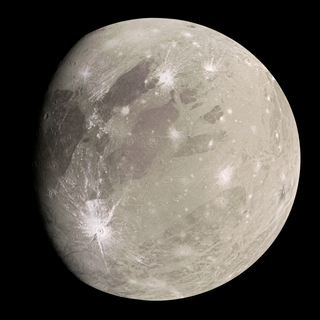Ganymede
Brahaspati ke ek chaand From Wikipedia, the free encyclopedia
Remove ads
Ganymede, Brahaspati ke chaand hae aur Saur Mandal ke sab se barraa hae. Saturn ke sab se barraa chaand, Titan ke rakam, ii grah p Mercury se barraa hae, lekin iske surface gravity Mercury, Io, aur Chandarma se kamti hae, iske kamti density ke kaaran.[18] Ganymede, Brahaspati ke lagbhag hae saat din orbit kare hae aur ii 1:2:4 orbital resonance me chaand Europa aur Io se hae.
- Galilei, Galileo; translated by Edward Carlos (March 1610). Barker, Peter (ed.). "Sidereus Nuncius" (PDF). University of Oklahoma History of Science. Archived from the original (PDF) on December 20, 2005. Retrieved January 13, 2010.
- "In Depth | Ganymede". NASA Solar System Exploration. Archived from the original on July 28, 2018. Retrieved June 16, 2021.
- Template:Cite OED
Template:Cite Merriam-Webster - Quinn Passey & E. M. Shoemaker (1982) "Craters on Ganymede and Callisto", in David Morrison, ed., Satellites of Jupiter, vol. 3, International Astronomical Union, pp. 385–386, 411.
- Journal of Geophysical Research, v. 95 (1990).
- E. M. Shoemaker et al. (1982) "Geology of Ganymede", in David Morrison, ed., Satellites of Jupiter, vol. 3, International Astronomical Union, pp. 464, 482, 496.
- "Planetary Satellite Mean Orbital Parameters". Jet Propulsion Laboratory, California Institute of Technology. Archived from the original on November 3, 2013. Retrieved February 9, 2008.
- Showman, Adam P.; Malhotra, Renu (October 1, 1999). "The Galilean Satellites". Science 286 (5437): 77–84. doi:10.1126/science.286.5437.77. PMID 10506564. Archived from the original on May 14, 2011. https://web.archive.org/web/20110514231040/http://www.lpl.arizona.edu/~showman/publications/showman-malhotra-1999.pdf. Retrieved January 17, 2008.
- Schubert, G.; Anderson, J. D.; Spohn, T.; McKinnon, W. B. (2004). "Interior composition, structure and dynamics of the Galilean satellites". In Bagenal, F.; Dowling, T. E.; McKinnon, W. B.. Jupiter: the planet, satellites, and magnetosphere. New York: Cambridge University Press. pp. 281–306. ISBN 978-0521035453. OCLC 54081598. https://books.google.com/books?id=aMERHqj9ivcC&pg=PA281. Retrieved July 23, 2019.
- Bills, Bruce G. (2005). "Free and forced obliquities of the Galilean satellites of Jupiter". Icarus 175 (1): 233–247. doi:10.1016/j.icarus.2004.10.028. https://zenodo.org/record/1259023. Retrieved July 13, 2019.
- Archinal, B. A.; Acton, C. H.; A'Hearn, M. F.; Conrad, A.; Consolmagno, G. J.; Duxbury, T.; Hestroffer, D.; Hilton, J. L. et al. (2018). "Report of the IAU Working Group on Cartographic Coordinates and Rotational Elements: 2015" (in en). Celestial Mechanics and Dynamical Astronomy 130 (3): 22. doi:10.1007/s10569-017-9805-5. ISSN 0923-2958. http://link.springer.com/10.1007/s10569-017-9805-5.
- Yeomans, Donald K. (July 13, 2006). "Planetary Satellite Physical Parameters". JPL Solar System Dynamics. Archived from the original on November 1, 2013. Retrieved November 5, 2007.
- Delitsky, Mona L.; Lane, Arthur L. (1998). "Ice chemistry of Galilean satellites". J. Geophys. Res. 103 (E13): 31,391–31,403. doi:10.1029/1998JE900020. https://trs.jpl.nasa.gov/bitstream/handle/2014/20675/98-1725.pdf.
- Orton, G. S.; Spencer, G. R. et al. (1996). "Galileo Photopolarimeter-radiometer observations of Jupiter and the Galilean Satellites". Science 274 (5286): 389–391. doi:10.1126/science.274.5286.389.
- Yeomans; Chamberlin. "Horizon Online Ephemeris System for Ganymede (Major Body 503)". California Institute of Technology, Jet Propulsion Laboratory. Archived from the original on February 2, 2014. Retrieved April 14, 2010. (4.38 on 1951-Oct-03).
- Hall, D. T.; Feldman, P. D. et al. (1998). "The Far-Ultraviolet Oxygen Airglow of Europa and Ganymede". The Astrophysical Journal 499 (1): 475–481. doi:10.1086/305604.
- "Ganymede Fact Sheet". www2.jpl.nasa.gov. Archived from the original on January 5, 1997. Retrieved January 14, 2010.
Remove ads
Wikiwand - on
Seamless Wikipedia browsing. On steroids.
Remove ads

